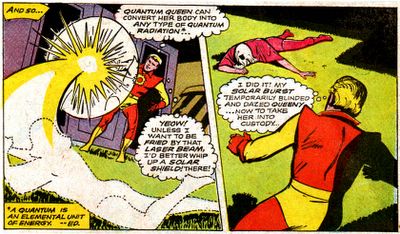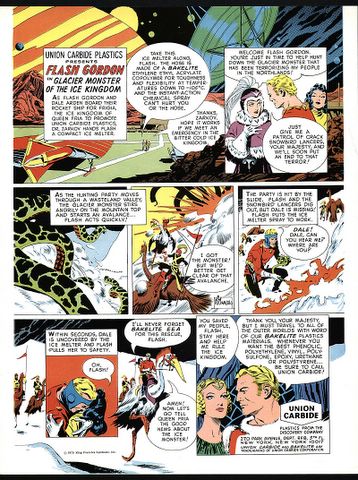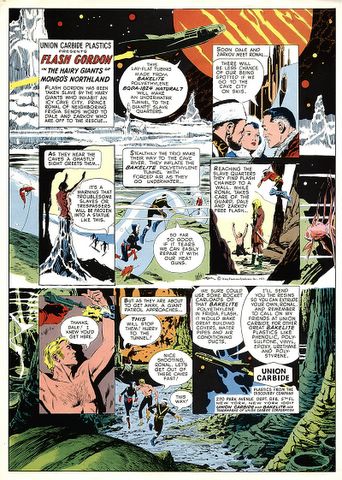
Sunday, December 17, 2006
Saturday, December 16, 2006
Smash Gordon by Frank Brunner

Art & story © Frank Brunner. CLICK IMAGE TO ENLARGE.
From the dusty Atomic Surgery Archives comes this strip from the legendary “Castle of Frankenstein” (#12, 1968).
Visit FrankBrunner.net
Vaughn Bodé’s 20,000 Leagues Under The Sea: Part 4



Back in the 60’s Vaughn Bodé illustrated a number of classics that had been rewritten for “reading challenged” kids. The books were published by Frank E. Richards and sold exclusively to schools.
Because these books are almost impossible to find at reasonable prices I’ll be posting all the illos from the best book of the bunch, “Jules Verne’s ’20,000 Leagues Under The Sea” in eight installments.
Read: Part 1 Part 2 Part 3 Part 4 Part 5 Part 6 Part 7 Part 8
All art © the estate of Vaughn Bodé
Friday, December 15, 2006
Born This Day: Gustave Eiffel
Dec. 15, 1832 – Dec. 28, 1923
Eiffel was a French civil engineer who specialised in metal structures, known especially for the Eiffel Tower in Paris. His work includes designing the rotatable dome for Nice Observatory on the summit of Mont Gros (1886), and the framework for the Statue of Liberty now in New York Harbour.
After building the Eiffel Tower (1887-9), which he used for scientific research on meteorology, aerodynamics and radio telegraphy, he also built the first aerodynamic laboratory at Auteuil, outside Paris, where he pursued his research work without interruption during WW I.
An Ode To Eiffel:
Eiffel was a French civil engineer who specialised in metal structures, known especially for the Eiffel Tower in Paris. His work includes designing the rotatable dome for Nice Observatory on the summit of Mont Gros (1886), and the framework for the Statue of Liberty now in New York Harbour.
After building the Eiffel Tower (1887-9), which he used for scientific research on meteorology, aerodynamics and radio telegraphy, he also built the first aerodynamic laboratory at Auteuil, outside Paris, where he pursued his research work without interruption during WW I.
An Ode To Eiffel:
This Day In History: The Origin of Nylon Stockings
On this day in 1939, nylon yarn was sold to hosiery mills to make women's stockings; marking the first use of commercial yarn for apparel. The product of DuPont enabled a record number of ladies' hose to go on sale for the first time in May, 1940. link
Thursday, December 14, 2006
On This Day: Quantum Physics Announced
In 1900, German physicist Max Planck made public his ideas on quantum physics at a meeting of the German Physics Society, revolutionizing scientists' understanding of physics.

Planck demonstrated that in certain situations energy exhibits characteristics of physical matter, something unthinkable at the time. He suggested the explanation energy exists in discrete packets, which he called "quanta." link

Sun Boy and Quantum Queen © DC Comics

Planck demonstrated that in certain situations energy exhibits characteristics of physical matter, something unthinkable at the time. He suggested the explanation energy exists in discrete packets, which he called "quanta." link

Sun Boy and Quantum Queen © DC Comics
Hell Is On Venus
Thanks to ESA’s Venus Express data, scientists obtained the first large-area temperature maps of the southern hemisphere of the inhospitable, lead-melting surface of Venus. The new data may help with searching and identifying ‘hot spots’ on the surface, considered to be possible signs of active volcanism on the planet.
To obtain this fundamental information about the surface temperature, VIRTIS made use of the so-called infrared spectral 'windows’ present in the Venusian atmosphere. Through these ‘windows’ thermal radiation at specific wavelengths can leak from the deepest atmospheric layers, pass through the dense cloud curtain situated at about 60 kilometres altitude, and then escape to space, where it can be detected by instruments like VIRTIS. In this way VIRTIS succeeded in looking through the thick carbon dioxide curtain surrounding Venus and detected the heat directly emitted by the hot rocks on the ground. On Venus there are no day and night variations of the surface temperature. The heat is globally 'trapped' under the carbon-dioxide atmosphere, with pressure 90 times higher than on Earth. Instead, the main temperature variation is due to topography. On Venus 'cold' means 447º C, while 'warm' means 477º C. Such high temperatures are caused by the strongest greenhouse effect found in the Solar System. link
Where is Robot Hell?
To obtain this fundamental information about the surface temperature, VIRTIS made use of the so-called infrared spectral 'windows’ present in the Venusian atmosphere. Through these ‘windows’ thermal radiation at specific wavelengths can leak from the deepest atmospheric layers, pass through the dense cloud curtain situated at about 60 kilometres altitude, and then escape to space, where it can be detected by instruments like VIRTIS. In this way VIRTIS succeeded in looking through the thick carbon dioxide curtain surrounding Venus and detected the heat directly emitted by the hot rocks on the ground. On Venus there are no day and night variations of the surface temperature. The heat is globally 'trapped' under the carbon-dioxide atmosphere, with pressure 90 times higher than on Earth. Instead, the main temperature variation is due to topography. On Venus 'cold' means 447º C, while 'warm' means 477º C. Such high temperatures are caused by the strongest greenhouse effect found in the Solar System. link
Where is Robot Hell?
Subscribe to:
Posts (Atom)












